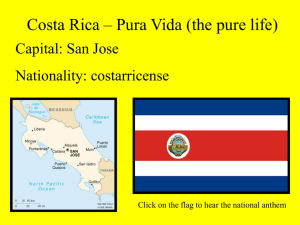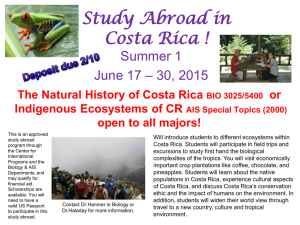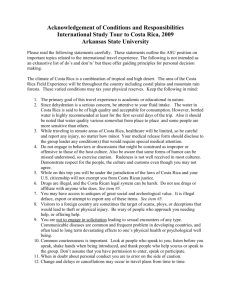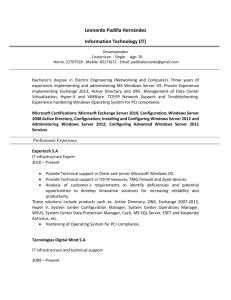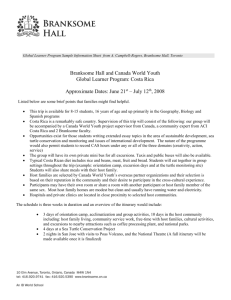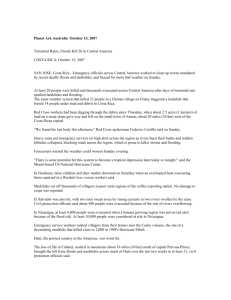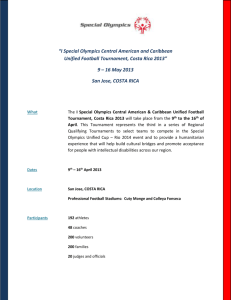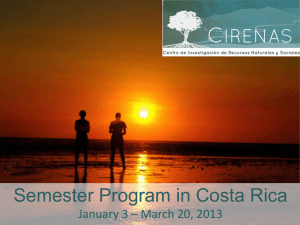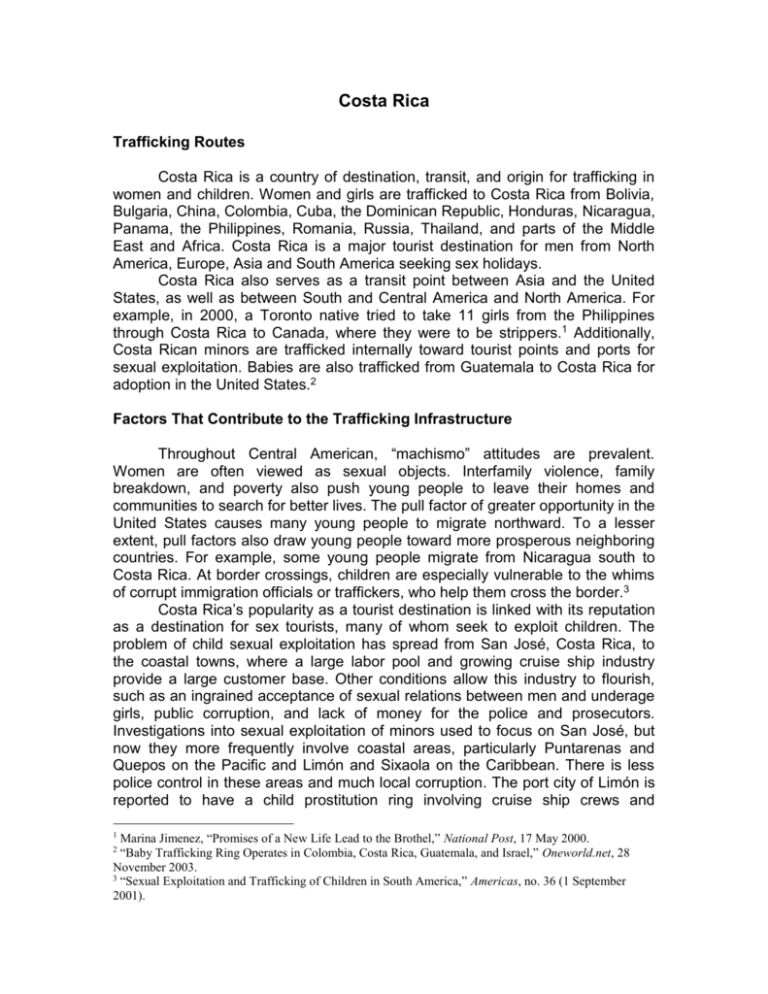
Costa Rica
Trafficking Routes
Costa Rica is a country of destination, transit, and origin for trafficking in
women and children. Women and girls are trafficked to Costa Rica from Bolivia,
Bulgaria, China, Colombia, Cuba, the Dominican Republic, Honduras, Nicaragua,
Panama, the Philippines, Romania, Russia, Thailand, and parts of the Middle
East and Africa. Costa Rica is a major tourist destination for men from North
America, Europe, Asia and South America seeking sex holidays.
Costa Rica also serves as a transit point between Asia and the United
States, as well as between South and Central America and North America. For
example, in 2000, a Toronto native tried to take 11 girls from the Philippines
through Costa Rica to Canada, where they were to be strippers.1 Additionally,
Costa Rican minors are trafficked internally toward tourist points and ports for
sexual exploitation. Babies are also trafficked from Guatemala to Costa Rica for
adoption in the United States.2
Factors That Contribute to the Trafficking Infrastructure
Throughout Central American, “machismo” attitudes are prevalent.
Women are often viewed as sexual objects. Interfamily violence, family
breakdown, and poverty also push young people to leave their homes and
communities to search for better lives. The pull factor of greater opportunity in the
United States causes many young people to migrate northward. To a lesser
extent, pull factors also draw young people toward more prosperous neighboring
countries. For example, some young people migrate from Nicaragua south to
Costa Rica. At border crossings, children are especially vulnerable to the whims
of corrupt immigration officials or traffickers, who help them cross the border.3
Costa Rica’s popularity as a tourist destination is linked with its reputation
as a destination for sex tourists, many of whom seek to exploit children. The
problem of child sexual exploitation has spread from San José, Costa Rica, to
the coastal towns, where a large labor pool and growing cruise ship industry
provide a large customer base. Other conditions allow this industry to flourish,
such as an ingrained acceptance of sexual relations between men and underage
girls, public corruption, and lack of money for the police and prosecutors.
Investigations into sexual exploitation of minors used to focus on San José, but
now they more frequently involve coastal areas, particularly Puntarenas and
Quepos on the Pacific and Limón and Sixaola on the Caribbean. There is less
police control in these areas and much local corruption. The port city of Limón is
reported to have a child prostitution ring involving cruise ship crews and
Marina Jimenez, “Promises of a New Life Lead to the Brothel,” National Post, 17 May 2000.
“Baby Trafficking Ring Operates in Colombia, Costa Rica, Guatemala, and Israel,” Oneworld.net, 28
November 2003.
3
“Sexual Exploitation and Trafficking of Children in South America,” Americas, no. 36 (1 September
2001).
1
2
operators: intermediaries on the ships contact tourists interested in the sex trade
and in having sex with willing young people.4 Investigations and studies have
found that child prostitution and child pornography rings in Central America are
linked and that they also have ties to groups involved in the drug trade and in
other illegal activities.5
Forms of Trafficking
Costa Rica has gained a reputation as a magnet for sex tourists. This
popular tourist destination has come to rival Thailand and the Philippines as one
of the world’s leading destinations for sex tourism.6 Most international sex tourists
come from the United States, Canada, Japan, Italy, China, and other South
American countries. For example, reports have shown the frequency with which
Canadian men travel to Costa Rica in order to take part in illicit sexual activities. 7
Every year 50,000 Canadians travel to Costa Rica, including thousands of men in
pursuit of sex with underage girls.8
An intersection in downtown San José, known as “ground zero,” is where
many American men gather for their sexual holiday. Within a few blocks of the
intersection are dozens of nightclubs, massage parlors, and 1-hour hotels. Many
of the women in prostitution are underage. One report investigated a group of
local Chicago men who traveled to San José, Costa Rica, together. The owner of
a well-known Irish Pub in Chicago organized the trip, and a Chicago policeman
and fireman were in the group.9 Some reports claim that local Costa Ricans
account for the bulk of the sex industry clients, 10 whereas one report says that 62
percent of sexually exploited children have been victims of foreigners. 11
Sex tourism operations depend on advertisements on the Internet, in
newspapers, and even in tourist magazines. In fact, at least 70 Internet sites
promote sex tourism in Costa Rica.12 Popular Web sites feature photographs of
girls, some of whom appear very young. Some Web sites show videos shot in
San José hotel rooms and give client ratings of each girl’s hygiene and
performance.13
Costa Rica is believed to have the region’s largest child prostitution
problem.14 One report claims that 3,000 underage girls are prostituted in Costa
James Varney, “Child Prostitutes Now Emerging in Costa Rica Towns,” Houston Chronicle, 17 May
2002.
5
“Poverty Spurs Growth of Child Sex Rings,” Inter Press Service, 14 October 2003.
6
Joseph Contreras, “The Dark Tourists,” Newsweek International, 2 May 2001.
7
Sean Mattson, “10 U.S. Citizens Arrested in Acapulco,” Guadalajara Reporter, 17 April 2003.
8
Ashante Infantry, “Perverts on Holiday Exposed,” Toronto Star, 6 March 2004.
9
Chuck Goudie, “Shameful Obsession,” ABC 7 News Chicago, 11 February 2004,
http://www.abclocal.go.com.
10
“Sexual Exploitation and Trafficking of Children in South America,” Americas, no. 36 (1 September
2001).
11
“Costa Rica Accepts to Discuss Sexual Tourism,” Casa Alianza, 6 May 2003.
12
“Putting the Sex Trade on Notice,” New York Times, 9 January 2004.
13
Chuck Goudie, “Shameful Obsession,” ABC 7 News Chicago, 11 February 2004,
http://www.abclocal.go.com.
14
Serge F. Kovaleski, “The Dark Side of the Tourism Industry,” Toronto Star, 9 January 2000.
4
Rica, many of them trafficked from Colombia, the Dominican Republic,
Honduras, and Nicaragua.15 Many children are promised work in Costa Rica,
only to be sexually exploited when they arrive. Costa Rican children are believed
to be trafficked to other countries for sexual exploitation purposes as well. 16
Government Responses
The Criminal Code prohibits promoting or facilitating the prostitution of
individuals of either sex17 and pimping as a means of livelihood.18 The code also
prohibits “trafficking in women and minors,” stating that “one who promotes or
facilitates the entry to or exit from the country of women or minors of either sex to
practice prostitution shall be punished by imprisonment of 3 to 6 years.” 19 The
penalty is 4 to 10 years’ imprisonment in cases of aggravated circumstances,
such as cases involving deceit, violence, abuse of authority, or other means of
intimidation or coercion or cases in which the perpetrator is an ancestor,
descendant, husband, sibling, or guardian or is in charge of the education, care,
or custody of the victim.20 The Criminal Code punishes the production of
pornographic materials using minors by imprisonment for 3 to 8 years. 21
The Narcotics, Psychotropic Substances, Illegal Drugs, and Related
Activities Act criminalizes the laundering of assets generated by specified
criminal actions.22 The act also allows the freezing, seizure, and confiscation of
assets stemming from the offenses covered by the act.23 The Office of the
Auditor General for Financial Bodies is the supervisory body that conducts audits
of banks and other nonbanking financial institutions. A decree of 199624 regulates
illegal enrichment of public employees. A 1995 decree25 requires sworn
declaration of assets by officers in all branches of government. The Law on Civil
Service and Administrative Careers of 1991 also addresses the ethics to be
practiced by civil servants.26
Costa Rica has launched investigations of crimes involving commercial
sexual exploitation of women and adolescents. Each of the country’s 10 police
districts established special delegations with investigators and prosecutors to
deal with these kinds of crimes.27
Chuck Goudie, “Shameful Obsession,” ABC 7 News Chicago, 11 February 2004,
http://www.abclocal.go.com.
16
“Nationals Reported to Outnumber Foreigners in Sexual Offences in Costa Rica,” Casa Alianza, 3
December 2003.
17
Article 169.
18
Article 171.
19
Article 172.
20
Articles 170(2) and (3).
21
Article 173.
22
Article 17.
23
Article 31.
24
Decree 24 991-MP of 13 February 1996, amending the regulation of Law No. 6872.
25
Decree 24 885-MP of 4 December 1995, approving the regulation of Law No. 6872.
26
Regulation No. 81-94 of 29 March 1994, governing the application of Law No. 14-91 of 10 May 1991.
27
Organization of American States, “‘Trafficking in Persons, Especially Women, Adolescents, and
Children:’ Summary of the Presentation to the ‘First Inter-American Meeting on Cooperation Mechanisms
15
In 2000, a 38-year-old Costa Rican woman was arrested in Costa Rica for
allegedly running a prostitution network that involved girls as young as 12 years
of age. Dubbed “Prostitution Express” by the media in Costa Rica, the 5-year-old
network was broken by the Organization of Judicial Investigation.28 That same
year a sex tourist was arrested for pimping adults and minors. He ran an escort
service for foreign visitors to Costa Rica that included offering minors for sex. His
advertisements were reportedly in the Costa Rican government’s official guide for
tourists for more than 8 years. Another man was arrested in San José after
offering minors for sexual services and sending girls as young as 12 to Costa
Rican hotels to have sex with foreign visitors.29
In 2001, nearly a year after they were arrested, three people were found
guilty of aggravated pimping of minors—in this case, six girls ranging in age from
12 to 17—in a brothel run out of a home. The girls were poor Costa Ricans and
Nicaraguans.30
In 2002, 10 foreign female victims of trafficking—Colombian, Nicaraguan,
and Romanian—were deported from Costa Rica after they were found in a San
José nightclub.31 In February 2002, a woman from the Dominican Republic was
jailed for 5 years in Costa Rica for trafficking young Dominican girls to Costa
Rica, where they were sexually exploited. She and her business partner, a
Dominican man, would offer young girls in the Dominican Republic jobs as
waitresses or in hotels in Costa Rica. Most of the victims were between 14 and
18 years of age. The girls would then be flown from Santo Domingo to San José,
where they would then be transported to the tourist town of Quepos (on the
Pacific coast) and to Squirres (on the Atlantic side) for sexual exploitation. 32 In
December 2002, the Costa Rican Immigration Authorities raided the Hotel del
Rey in San José, a known center for prostitution in Costa Rica. As the results of
the raid showed, many of the women working in prostitution at the hotel had been
trafficked or smuggled into the country and were being exploited.33
As of October 2003, the government office for the prosecution of sexual
crimes had only five investigators, despite the increasing number of reports of the
problem.34
In June 2003, the Third Room of the Supreme Court of Justice of Costa
Rica confirmed the sentence against five men accused of corruption of minors,
first handed down in December 2002. Among the accused were a government
official and a lawyer, both members of the Association of Anonymous Pedophiles
of Costa Rica. They were arrested after 8 months of investigations by Casa
Alianza, a nongovernmental organization (NGO), the Sexual Exploitation Unit of
the Ministry of Security, and the Sexual Crimes Prosecutor of the Public Ministry.
against Organized Crime,’ Held in Mexico, October 6–8, 2003,” Americas Forum 3, no. 7 (August 2003),
http://www.oas.org/ezine/ezine22/Trafficking.htm.
28
“Costa Rican Police Busts Child Prostitution Ring,” Honduras This Week On Line, 12 November 2000.
29
“Costa Rica: Moves to Curb Child Prostitution,” Casa Alianza, 14 November 2000.
30
“Costa Rica: Three Pimps Jailed for Selling Child Sex,” Casa Alianza, 9 March 2001.
31
“Trafficked Women Deported from Costa Rica,” La Nación, 11 November 2002.
32
“Traffickers of Girls from Dominican Republic to Costa Rica Jailed,” Casa Alianza, 25 February 2002.
33
Bruce Harris, “Raid on Hotel del Rey,” Casa Alianza, 23 December 2002.
34
“Poverty Spurs Growth of Child Sex Rings,” Inter Press Service, 14 October 2003.
In September 2003, investigators rescued nine Guatemalan infants assumed to
have been for sale to foreigners from a home in western San José. Five
Guatemalan women, a Honduran woman, and a former Costa Rican bank
manager were arrested.35
In late 2003, Costa Rican authorities requested an international arrest
order against an Israeli citizen through the First District Penal Court in San José
as a result of an investigation into trafficking in Central American babies. The
Israeli man founded the international Adoption Resources Foundation in Costa
Rica to facilitate international adoptions.36
Nongovernmental and International Organization Reponses
The NGO Casa Alianza is dedicated to the rehabilitation and defense of
street children in Guatemala, Honduras, Mexico, and Nicaragua. The Latin
American branch of Covenant House of New York, Casa Alianza has been
headquartered in San José, Costa Rica, since 1993. Originally founded in
Guatemala in 1981, the organization moved into Honduras and Mexico in 1986
and into Nicaragua in 1998. The Costa Rican office coordinates and supports
Casa Alianza activities in the four countries of operation. Casa Alianza monitors
and cares for some 9,000 street children each year, most of whom were
orphaned by civil war, were abused or rejected by their poverty-stricken or
dysfunctional families, and were traumatized by the lack of protection and care in
society. The organization coordinates a wide range of activities—including
lobbying and publishing, coordinating with NGOs and governmental
organizations, and investigating offenses—to promote the well-being and
defense of neglected and vulnerable children.37 The Human Rights Ombudsman
for Costa Rica chose to honor Casa Alianza for its work for the rights of children
by awarding it the “Contribution to the Improvement of the Quality of Life” award
in October 2003 in San José.38 In 2000, the organization received the milliondollar Conrad Hilton Prize, considered the world’s top humanitarian award.39
Fundación Paniamor, a local Costa Rican NGO, promotes social
mobilization on the issue of children’s rights by disseminating information,
offering training and research, acting as a political advocate, and providing
services to adolescents.40
“Costa Rica Cracks Child Smuggling Ring,” Agence France Presse, 23 September 2003.
“Baby Trafficking Ring Operates in Colombia, Costa Rica, Guatemala, and Israel,” Oneworld.net, 28
November 2003.
37
Casa Alianza can be found on the Internet at http://www.casa-alianza.org.
38
“Costa Rica: Casa Alianza Honored with ‘Contribution to the Improvement of the Quality of Life,’”
Casa Alianza, 22 October 2003.
39
“News/Costa Rica: Sex Trade on the Rise and Out of Control,” Inter Press Service, 30 November 2000.
40
End Child Prostitution, Pornography, and Trafficking (ECPAT) International Online Database, 30 March
2002, http://www.ecpat.net.
35
36
Multilateral Initiatives
The Eighth Meeting of the Regional Conference on Migration took place in
Cancún, Mexico, on 28–29 May 2003. Representatives of Belize, Canada, Costa
Rica, the Dominican Republic, El Salvador, Guatemala, Honduras, Mexico,
Nicaragua, Panama and the United States met to focus on intensifying
cooperation to combat smuggling and trafficking of persons, among other
migration issues.41
“Declaration,” Regional Conference on Migration (Puebla Process) VII Meeting, Cancún, Quintana Roo,
Mexico, 29–30 May 2003.
41

